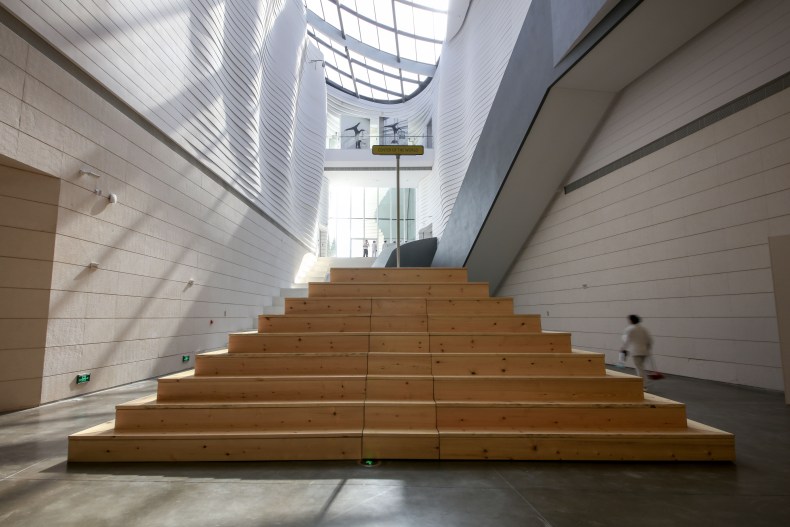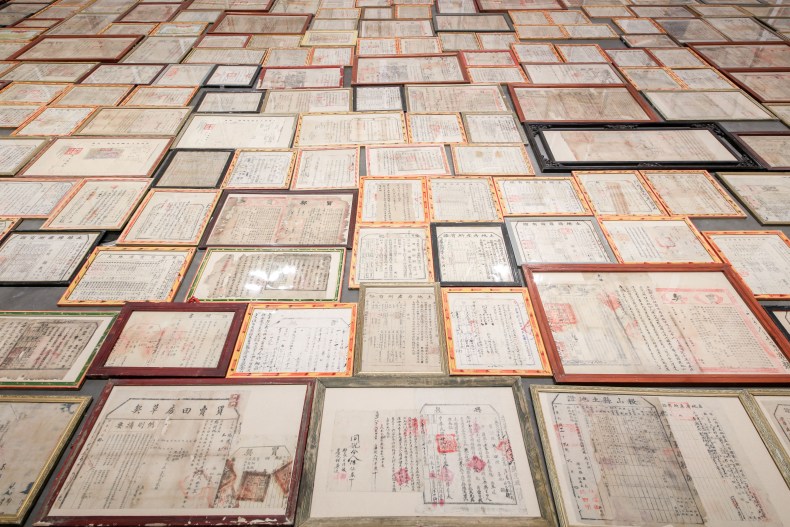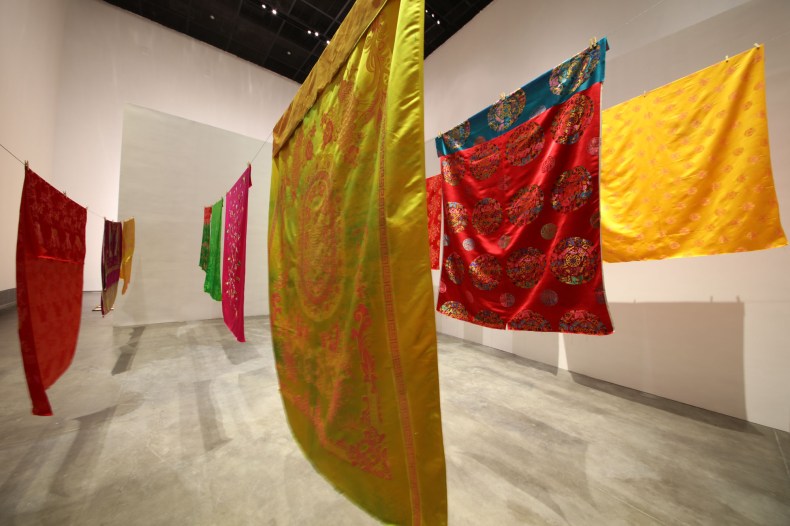Yinchuan is the capital of the Ningxia Hui Autonomous Region in north-west China. It is the official home of China’s Hui Muslims, the second largest of the country’s 56 recognised minorities and, in the past decade, billions of dollars of state funding have poured into the region. In 2013 Yinchuan was singled out as the pilot city for China’s ‘smart city’ programme and in 2016 it hosted the Smart City Forum, with delegates from 66 countries invited to admire the city’s technological innovations (think: solar-powered bins). The first Yinchuan Biennale, one of many contemporary art events emerging in Asia, and part of China’s biennale boom, was held in the same year.
The second edition has been curated by Marco Scotini, a seasoned Milan-based curator and critic. Over the years, he has worked on iterations of Venice, Kassel, Manifesta; most recently, in 2017, he co-curated the first edition of a biennale in Anren, a small town with a population of 400,000 on the outskirts of Chengdu.
Holding true to the international spirit of the ’90s biennale model the event features 90 participating artists from 30 different countries. There is, however, a decided focus on Mongolia and Central Asia; the first Yinchuan Biennale was curated by Bose Krishnamachari, founder of Kochi. The regional focus continues in the second edition yet Scotini’s curating somewhat blurs the notion of decentralising the Western canon; among works by artists from Ulaanbaatar, Bishkek and Shymkent there are pieces by half a dozen artists from Italy, including Piero Gilardi’s mid-century artificial gardens and embroidery by Alighiero Boetti.
It takes place at the Yinchuan Museum of Contemporary Art (MOCA), an enormous white ribbed building, which opened in 2015 as the first contemporary art museum in north-west China. It was funded by a regional property developer in partnership with the government and, as an odd interlude to the art, it includes a BMW showroom with rows of minted cars. Located about 40 minutes outside Yinchuan, on a site where tower blocks peter into rice fields, it’s not a building you stumble upon. Most visitors arrive here, on schedule and by coach.

The Center of the World (2018), Song Dong, installation view at the Yinchuan Biennale. Courtesy the Yinchuan Biennale
Titled ‘Starting from the Desert’, the biennale looks at the way climate change affects minorities and nomadic people. The English part of bilingual exhibition guide is dense with ‘International Art English’, as it’s become known, a mode of writing that is not always lucid, replete with such terms as ‘nomadic science’, ‘the semiotics of subjectification’ and ‘ecologies on the edge’. What is missing, however, is a concrete overview of where are we, and why we are here.
The biennale brings together more than 100 works hailing from diverse locations and speaking of very different political struggles. I enter the atrium to see a wooden structure by Song Dong, which I climb to find samples of desert sand held at its summit. It also provides a lookout point from where I try to get a handle on what is to come. To the left is a set of rooms full of textiles including Said Atabekov’s pile of Western flags made from Uzbekistani fabrics, and Kimsooja’s row of South Korean textiles, hanging on lines like laundry in the yard. Most interesting, perhaps, is the work of Mao Tongqiang, an artist from Yinchuan, who, in a work titled Leasehold (2009), takes up a substantial part of one wall with a patchwork of framed archival documents. Each stamped document is an obsolete certificate of landownership collected by the artist.

Leasehold (2009), Mao Tongqiang, installation view at the Yinchuan Biennale. Courtesy Yinchuan Biennale
The biennale unfolds over the museum’s three floors, with performances taking place outdoors, and solo exhibitions in a second building called the International Artists Village, which is on the far side of the car showroom. I spend an hour on the third floor in a series of rooms titled ‘Labour in Nature and Nature in Labour’, which feature overlapping installations about labour movements in Senegal, Brazil, Mexico and Turkey, shown alongside Huxian Peasant Painters from the 1970s and ancient Hui artefacts. The museum’s permanent collection of Qing-era paintings is also on display, and acts as a backdrop for some of the works in the biennale, such as Tangka paintings by the Tibetan artist Tsechang Penba Wangdu. These scrolls show traditional maps of Tibet contained within the outline of a demon. Given China’s ongoing annexation of Tibet, it seems slightly remarkable for the work to be included in the show.
The biennale is messy, but there are moments of discovery and delight, such as a surreal mural by Prabhakar Pachpute that unfolds up one wall, showing miners with bolts for heads bending to water tiny terracotta mountains that grow out of emaciated skulls. I spent a long time looking at a set of photographs by the Chinese artist Zhuang Hui. One shows a classical ruin cast in iron that is tinted indigo and which sits alone in a desert. I read that Zhuang drove four of his sculptures into the Gobi Desert in 2014, to abandon them. The barren sands, sharpened skyline and a glistening, aqueous ruin form a beautiful, slippery composition.

A Laundry Woman (2000/2018), Kimsooja, installation view at the Yinchuan BIennale. Courtesy Yinchuan Biennale
True to the biennale’s theme, minorities in various parts of the world are the subject of some of the commissions, such as Karan Shrestha’s 30-minute documentary about an indigenous community in south-west Nepal, or Shiva Gor’s selection of objects made by the Banjara nomadic community in northern India. A curious, vexing omission from the biennale, however, is a discussion of the Hui people or the northern regions of China. The texts remind visitors of Ningxia’s important role as a trading post on the old Silk Road. What is not mentioned, however, is Ningxia’s contemporary strategic importance on the new silk road: the One Belt One Road initiative, which aims to join China to the Arab world with a route that runs right through Ningxia.
Yinchuan in fact hosts two biennales – the event at MOCA event, and the China-Arab States Expo. In 2017, the Expo’s catchy title was ‘Towards a New Model of Partnership Featuring Results-oriented and Win-win Cooperation’. And by 2020, Yinchuan is set to become a ‘World Muslim City’ – a tourist destination for the Islamic world, with new hotels, mosque, and an Islamic theme park (complete with a replica Taj Mahal). Yinchuan is the relatively contented face of Muslim China; in the autonomous region of Xinjiang thousands of Uyghur Muslims have been arrested and detained in recent years and travel to the region is often restricted by the authorities. Yinchuan, however, is open for business – and art.
The Yinchuan Biennale is at the Museum of Contemporary Art Yinchuan, China until 19 September.














![Masterpiece [Re]discovery 2022. Photo: Ben Fisher Photography, courtesy of Masterpiece London](http://zephr.apollo-magazine.com/wp-content/uploads/2022/07/MPL2022_4263.jpg)
Suzanne Valadon’s shifting gaze